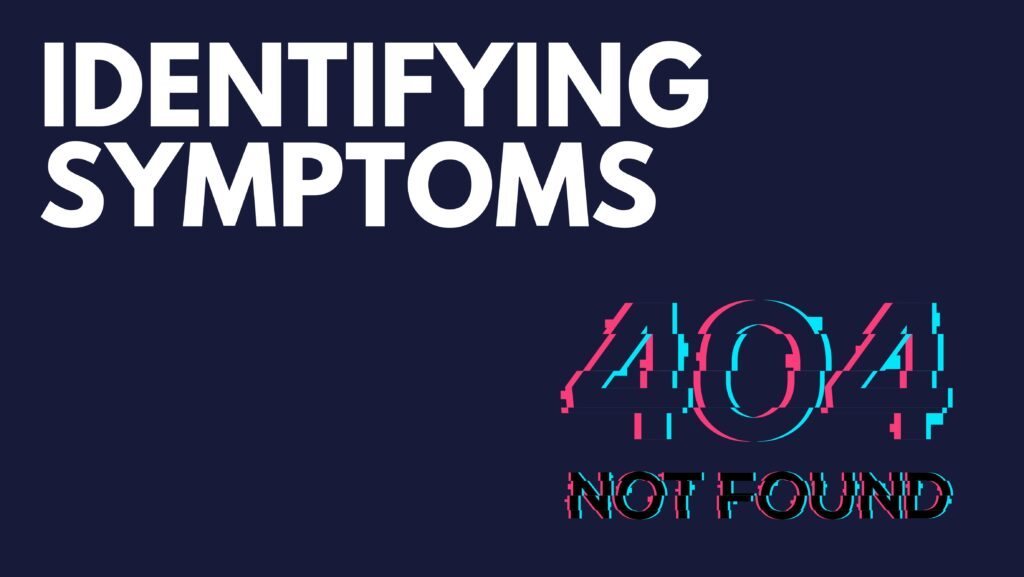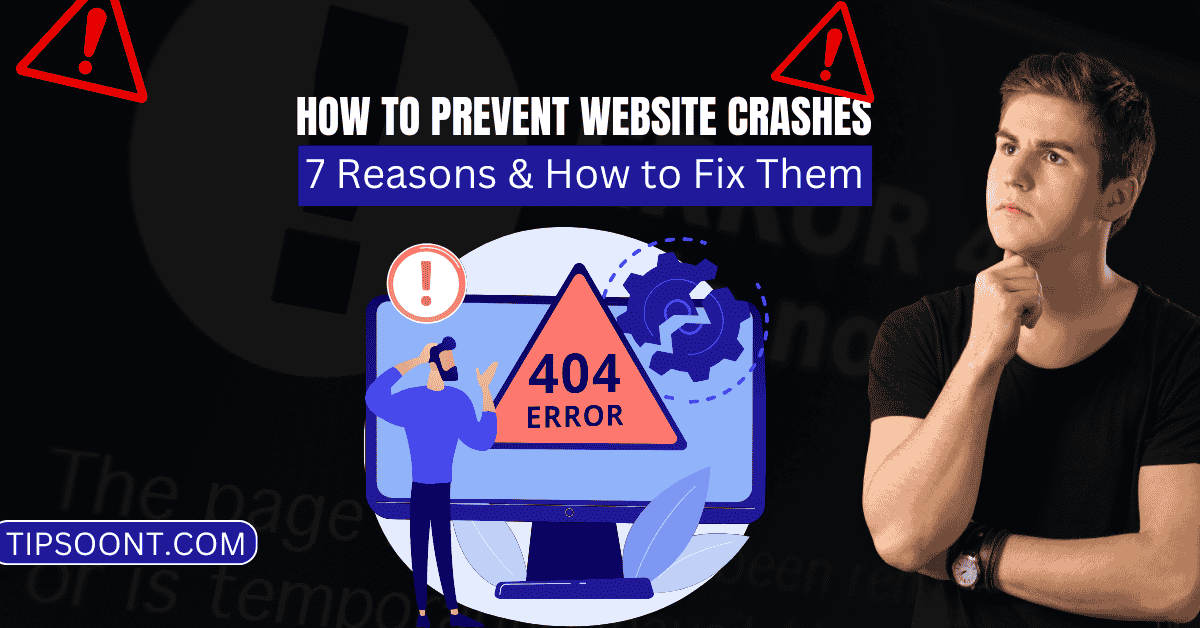p Websites serve as the backbone of businesses, communication, and access to information. However, even the most robust websites can face crashes, leading to significant disruptions. Understanding the causes, symptoms, and prevention strategies is crucial for maintaining a reliable online presence.
In this article, we will learn about modern challenges, advanced practices, and insights to protect your website from crashes while exploring the ethical and legal implications.
What is a Website Crash?
A website crash occurs when a website becomes inaccessible or unresponsive to users due to technical, security, or performance-related issues. Instead of delivering the desired content, users encounter error messages or blank screens.
Why Do Websites Crash? Most Common 7 Reasons

Websites crash due to a variety of reasons, each impacting the site’s functionality and accessibility. These issues can stem from technical glitches, security vulnerabilities, or external threats. Let’s find the common causes to understand how they contribute to website crashes and why addressing them is essential for maintaining a seamless online presence.
1. Server Overloads
One of the most frequent reasons for a website crash is server overload. When a website experiences a sudden surge in traffic beyond its server capacity, it can result in downtime. For instance, during events like flash sales, viral campaigns, or breaking news, an unprepared server may fail to handle the influx of visitors.
2. DDoS Attacks
Distributed Denial-of-Service (DDoS) attacks are malicious attempts to flood a website with excessive traffic from multiple sources. These attacks aim to overwhelm the server, rendering the website inaccessible. DDoS attacks are often difficult to mitigate and can last for hours or even days, causing significant disruption.
3. Software or Hardware Failures
Websites rely on both hardware (servers, storage devices) and software (content management systems, plugins). If either experiences a failure, the site may crash. For example, outdated plugins, untested updates, or hardware malfunctions can disrupt operations.
4. Coding Errors
Poorly written code or unoptimized scripts can lead to functionality issues. A minor typo or misconfiguration in the code can trigger server errors, resulting in downtime. This is especially common during development or updates when proper testing is skipped.
5. Cybersecurity Breaches
Hackers often exploit vulnerabilities in websites to inject malicious code, steal data, or crash the site entirely. Such breaches not only disrupt operations but also compromise sensitive user data, leading to reputational and financial losses.
6. Third-Party Dependencies
Many websites rely on third-party services such as payment gateways, APIs, or content delivery networks (CDNs). If these services experience outages, they can affect the website’s performance or render certain functionalities unusable.
7. Human Errors
Unintentional mistakes, such as incorrect server configurations, accidental deletion of files, or uploading faulty code, can result in crashes. While these errors are preventable, they remain a common cause, particularly among inexperienced administrators.
Understanding these causes is crucial for preventing website crashes. By identifying vulnerabilities and addressing them proactively, website owners can enhance their site’s stability and ensure uninterrupted service for their users.
How Cloud Services Impact Website Stability
Cloud services provide scalability and reliability, but they are not immune to failures. Outages in major cloud platforms can affect thousands of websites simultaneously.

Identifying Symptoms of a Website Crash
Recognizing the warning signs of a potential crash can help mitigate the damage:
- Slow Loading Times: Consistently slow page speeds indicate server strain.
- Frequent Error Messages: Errors like “500 Internal Server Error” signal backend issues.
- Unresponsive Features: Broken forms or buttons may suggest underlying problems.
- Unexpected Downtime: Periodic outages could precede a major crash.
Advanced Practices to Avoid Website Crashes

Preventing website crashes goes beyond basic troubleshooting and requires a proactive approach. Implementing advanced practices ensures your website remains stable, secure, and capable of handling unexpected challenges. Below are some detailed strategies to avoid website crashes:
1. Regular Maintenance and Updates
Maintaining your website’s infrastructure is crucial for preventing crashes. Outdated software, plugins, or frameworks can create compatibility issues, leaving your website vulnerable to errors and attacks. Regular updates ensure your site is running on the latest and most secure versions.
2. Load Testing
Load testing involves simulating high-traffic scenarios to evaluate how your website performs under stress. This process helps identify potential bottlenecks and weak points in your infrastructure.
3. Robust Hosting Solutions
Investing in reliable hosting is one of the most important steps to avoid website crashes. Low-quality hosting providers may lack the resources to handle traffic spikes or offer inadequate support during outages.
- Why It Matters: A robust hosting provider ensures consistent uptime, scalability, and faster load times, all of which are critical for user experience and search engine rankings.
- Best Practices: Opt for hosting providers with a proven track record, such as AWS, Google Cloud, or dedicated hosting services. Look for features like content delivery networks (CDNs), auto-scaling, and 24/7 support.
4. Real-Time Monitoring
Real-time monitoring tools continuously track your website’s performance and alert you to potential issues before they escalate into crashes. These tools analyze server health, response times, and error rates to ensure everything is running smoothly.
5. Implement Redundancy
Building redundancy into your website infrastructure ensures that a backup system takes over if the primary system fails. This includes redundant servers, databases, and storage solutions.
6. Optimize Website Code
Efficient and well-written code reduces the likelihood of errors and improves overall performance. Poorly optimized code can cause slow loading times and increase the risk of crashes.
7. Backup and Disaster Recovery Plans
Even with the best preventive measures, crashes can still occur. A robust backup and disaster recovery plan ensures you can restore your website quickly with minimal data loss.
8. Utilize AI and Automation
Incorporate AI-driven tools to predict potential issues and automate routine maintenance tasks. AI can help identify traffic spikes, security threats, and server failures before they impact your site.
Also Read: Detailed Updraft Blog: Secure Your WordPress Website Using Updraft Plus Backups in 2024
The Role of Artificial Intelligence in Crash Prevention
In the modern digital landscape, Artificial Intelligence (AI) plays a transformative role in maintaining website stability and preventing crashes. With its ability to analyze vast amounts of data and identify patterns, AI is increasingly becoming a cornerstone in proactive website management. Here’s how AI contributes to crash prevention:

1. Analyzing Traffic Patterns
AI-powered tools continuously monitor website traffic and analyze patterns to identify unusual spikes. By differentiating between legitimate traffic surges, like seasonal shopping events, and potential threats, such as DDoS attacks, AI helps in managing resources efficiently. For instance, AI can alert administrators to deploy additional server capacity during high-traffic periods to avoid overload.
2. Early Detection of Security Threats
AI excels at detecting and mitigating cybersecurity risks. By analyzing behaviour and access patterns, AI tools can identify potential threats, such as unauthorized access attempts, malicious bots, or vulnerabilities in the website’s code. This early detection enables website owners to neutralize threats before they escalate into full-blown crashes.
3. Predictive Maintenance
AI leverages predictive analytics to foresee potential failures in hardware or software components. For example, if a server is underperforming or a plugin shows signs of incompatibility, AI can predict the likelihood of a crash and recommend timely intervention, such as updates or hardware replacements.
4. Automated Error Resolution
AI systems are designed to not only detect errors but also resolve them autonomously in some cases. For instance, AI can restart crashed processes, patch vulnerabilities, or roll back faulty updates, ensuring minimal downtime and operational continuity.
5. Load Balancing Optimization
AI facilitates intelligent load balancing by dynamically distributing traffic across multiple servers. This ensures that no single server is overwhelmed, reducing the risk of crashes during high-demand scenarios.
6. Enhanced User Experience
By monitoring user interactions and website performance, AI can optimize the site’s functionality in real time. This includes identifying slow-loading pages, reducing latency, and ensuring seamless navigation, all of which contribute to a stable website.
7. Adaptive Learning and Scalability
AI systems learn and evolve with time, adapting to the specific needs of a website. As the website grows, AI can scale its monitoring and preventive measures, ensuring that even complex and resource-intensive sites remain crash-free.
Real-World Applications of AI in Crash Prevention
- Cloudflare’s AI-driven DDoS Protection: Automatically detects and mitigates large-scale attacks.
- Google’s AI Monitoring Systems: Helps predict server failures and optimize resource allocation.
- AI Tools like Dynatrace and New Relic: Offer real-time insights into website performance and health, enabling proactive management.
AI empowers website owners with the ability to anticipate and prevent potential crashes rather than merely reacting to them. By integrating AI-driven solutions into their infrastructure, businesses can achieve higher reliability, reduced downtime, and enhanced user trust.
Also Read: Kinsta Alternatives: 10 Best Kinsta Replacements
Cybersecurity: The Rising Threat

-Ransomware Attacks
Cybercriminals may encrypt your website’s data and demand payment for its release. So be safe by checking the security of a site before proceeding any type of payment.
-Phishing Exploits
Hackers often use fake websites to steal user credentials, which can indirectly affect your site’s reputation and security.
Understanding Third-Party Risks
Websites often rely on third-party services like payment gateways, APIs, and content delivery networks (CDNs). A failure in these services can impact your site’s functionality.
Ethical Hacking and Vulnerability Testing
Hiring ethical hackers to test your website’s defences helps uncover vulnerabilities and strengthen security measures.
Legal and Ethical Implications of Crashing a Website
Intentionally crashing a website is illegal, and punishable under cybercrime laws. It can result in fines, imprisonment, or both. Ethical considerations emphasize the importance of reporting vulnerabilities instead of exploiting them.
Website Crashed vs. Website Down
The terms “website crashed” and “website down” are often used interchangeably, but they refer to different scenarios. Understanding this distinction is essential for diagnosing and addressing issues effectively.
Website Crashed
A website crash refers to an unplanned failure of a website caused by underlying technical or security issues. This type of failure is sudden and often leads to complete inaccessibility of the site. Crashes can occur for several reasons, such as server overloads, software bugs, or cyberattacks.
Website Down
A website being “down” refers to a planned or temporary state of inaccessibility. This situation is usually intentional or due to minor disruptions, such as routine maintenance, updates, or small technical glitches. Unlike crashes, downtime is often anticipated and managed with minimal impact on users.
Comparison Table:
| Aspect | Website Crashed | Website Down |
|---|---|---|
| Nature | Unplanned and unexpected failure | Planned or temporary inaccessibility |
| Cause | Technical, security, or hardware issues | Maintenance or minor disruptions |
| Impact | Significant downtime and potential data loss | Minimal downtime, no data loss |
| Resolution Time | Depends on the complexity of the issue | Typically resolved quickly |
| Error Messages | 500 errors, 404 errors, blank pages | Maintenance notifications or temporary errors |
How to Handle Each Situation
For Website Crashes:
- Identify the root cause immediately.
- Use monitoring tools to detect and resolve server or code issues.
- Restore backups if necessary.
- Strengthen security measures to prevent recurrence.
For Website Downtime:
- Notify users in advance if downtime is planned.
- Use “under maintenance” pages to inform visitors.
- Ensure updates or maintenance tasks are completed efficiently.
The Financial Impact of Website Crashes

-Revenue Loss
E-commerce sites can lose thousands of dollars per minute of downtime.
-Brand Damage
Frequent crashes erode customer trust and tarnish brand reputation.
-Recovery Costs
Restoring a crashed website often involves significant financial and time investments.
A Statista study revealed that 25% of respondents reported average server downtime costs ranging from $301,000 to $400,000 per hour.
Report by: New Server Life
Emerging Technologies to Prevent Crashes
–Edge Computing
By processing data closer to users, edge computing reduces latency and prevents overloads.
-Blockchain for Secure Hosting
Blockchain technology offers decentralized hosting, reducing single points of failure.
Disaster Recovery Plans: Be Prepared
Develop a detailed disaster recovery plan that includes backup strategies, communication protocols, and a timeline for restoring services. With this plan, you can save your website from a big loss of its reputation or revenue.
Monitoring Tools for Website Health
Leverage advanced tools like New Relic, Pingdom, or Google Search Console to track uptime, performance, and security issues. These tools will help you to prepare for the upcoming challenges that can harm your website.
Tips for Visitors When a Website Crashes
If you encounter a crashed website:
- Check your internet connection to rule out local issues.
- Clear your browser cache and cookies.
- Use tools like DownDetector to confirm if the website is down globally.
Closing Words
Website crashes are an inevitable challenge in the digital era. However, understanding their causes, symptoms, and prevention techniques can significantly reduce their impact. Regular updates, robust hosting, and proactive monitoring are essential for maintaining website stability.
By adopting modern technologies and staying informed about emerging threats, website owners can ensure seamless user experiences and protect their businesses from the costly consequences of crashes.
Also Read: 10 Advanced WordPress SEO Tips to Boost Rankings Fast
Till Next Stay Connected With Us 🙂
- How to Prevent Website Crashes: 7 Reasons & how to Fix Them - February 28, 2025
- What is Cloaking in SEO? Examples, Risks & Tools - November 26, 2024
- 10 Advanced WordPress SEO Tips to Boost Rankings Fast - November 17, 2024







